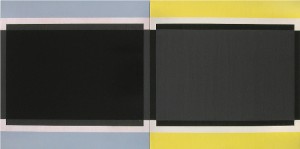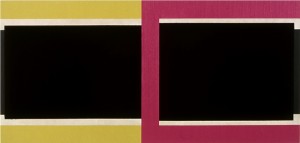Minus Space
Interview with Don Voisine
by Matthew Deleget
Minus Space – November 2003
http://www.minusspace.com/

Don Voisine, Surf and Sun, 2006, oil on wood, 12 x 24 in.
The following interview was published on MINUS SPACE in November 2003 in conjunction with Don Voisine’s spotlight exhibition.
Matthew Deleget: Architecture is the first word you use to describe your work. How is your work architecture and how is it not?
Don Voisine: In my statement I speak of architecture as describing space and its limits (the infinite constitutes one such limit) and in terms of a passage, from here to there. These paintings can be seen as being concerned with limits, restrictions, controlled or limited access. For example, expanses are cut off by borders. The transparent or translucent center ‘scrim’ limits the spatial depth suggested by the layering and overlapping of a number of elements.
Years ago the imagery of my painting derived from floor plans of places where I lived or worked. This has been reduced to more elemental aspects of place. Although I take into consideration ideas related to architecture, I am not designing anything that could be built. I remain firmly two dimensional.
MD: Similar to modular architecture, many of the paintings you made during the past two years are serial in nature. They consist of individual, interchangeable panels which you assemble together in very specific combinations. How did the modular unit become part of your vocabulary? And what is your thought process for determining specific modular combinations?

Don Voisine, Spring Line, 2007, oil on wood, 12 x 50 in.
DV: I had been working on wood panels for a few years and wanted to do larger scale works. Large wooden panels are very heavy and warping becomes an issue. By expanding laterally with multiple panels, I could get the effect of a large painting with less square footage.
One looks at or into a small painting. With a larger piece the viewer becomes more aware of their one-on-one relation to the painting as well as the space and light surrounding it. The color combinations draw your eye in or out and across the span. I determine the sequence of the panels to facilitate this.

Don Voisine, Another Morning, 2005, oil on wood, 16 x 33 in.
MD: The square in your work seems to be omnipresent. It is like a basic building block – a point of departure.
DV: The square is something I use to build the paintings. It is a given with an inherent structural logic. The shape is pure with perhaps fewer narrative associations then other shapes. It establishes a balance which is then subtly altered through color, borders, and other considerations specific to that particular painting. The square itself may not be manifestly ‘interesting’ so the challenge is to make it worth looking at. I don’t have too much at stake in the nominal shapes that make up the pictures. I’m interested in the effect of the whole, something you experience as well as see.
MD: Nearly all of your paintings are composed around dark, subtly layered center spaces, which read as empty and silent. You offset these areas, however, with very forceful colors – such as red, yellow, and turquoise – which you confine to thin strips around the outside edges of your paintings. Discuss the way you structure color in your paintings.
DV: For me, this is largely intuitive and subjective. The structure of a piece is pretty well set by the time I start a painting. Color, texture, degrees of transparencies, densities, etc. are worked out in the process of painting and are particular to individual paintings. The color (other than the black) establishes the tone and timbre of a painting and seeks to activate the interior void. With such large areas of darkness, I don’t want my work to read as gloomy and somber and I mean the color of the perimeter strips to counter that expectation.
MD: Unlike many abstract painters, who prefer to leave their works untitled, you have titled many of your paintings with names that to me suggest a certain degree of nostalgia. Even your color choices and color combinations seem to hark back to by-gone eras of American Pop culture, specifically the 1950s and 60s.

Don Voisine, American Splendor, 2006 oil on wood 24 x 59 in.
DV: I think most abstraction attempts to articulate the gap between language and the senses, an area that is not appropriated by narrative structure. Lack of a title is merely a declaration of that fact.
I use titles as a means of identification, not to explain the painting. Numbering paintings seems too bureaucratic. A color or shape may suggest an association, something I heard while working may ‘attach’ itself to a painting. It’s also a way to bring humor to serious looking work. I once titled a triptych “Can’t Understand It†and noticed it would make most people smile because we’ve all felt that at some point looking at art.
I’m not sure if I consciously choose colors that relate to a particular era. I get ideas for colors from all kinds of places, often observed. Colors glimpsed on the side of a passing truck, a Benjamin Moore color chart, a fabric, etc. I rarely use a pure red, yellow, or blue, I will skew it in some direction or other. Even the blacks are tinted slightly.
MD: Let’s talk now for a moment about the drawings you have posted on the web site. Unlike your paintings, you’ve used repetitive lines to fill in space rather than shading. You’ve also consciously decided to draw the lines by hand rather than with a straight edge. How is your drawing process different than your painting process? How are they similar?

Don Voisine, untitled, 2008, ink on paper, 5 x 5 in.
DV: The paintings and drawings are both made in a very straight forward manner, no tricks, no flourishes, and no fancy mediums. Both display some evidence of the hand within the structure of the grid. The paintings are made by simply overlaying or abutting planes or bands, generally combining no more then 4 or 5 elements, while the drawings are an accumulation of hundreds of small marks within a given area. Each ¼ inch grid square on the page can hold from 4 to 15 lines. The accumulated starts and stops of the hand drawn lines create a shimmer across the page, activating the field. Although tape is used to mask off areas, my paintings are obviously hand painted and also gain some visual buzz from its imperfections.
